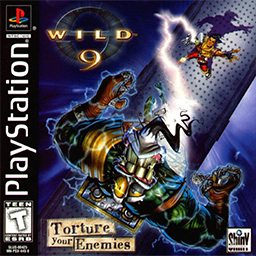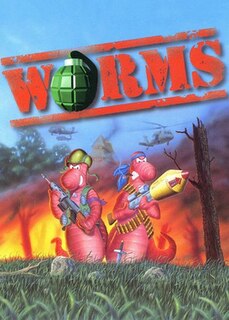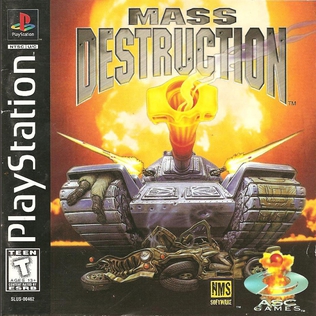| Pitball | |
|---|---|
 | |
| Developer(s) | Warner Interactive Europe |
| Publisher(s) | |
| Platform(s) | PlayStation |
| Release | |
| Genre(s) | Sports |
Pitball is a video game developed and published by Warner Interactive Europe for the PlayStation.
| Pitball | |
|---|---|
 | |
| Developer(s) | Warner Interactive Europe |
| Publisher(s) | |
| Platform(s) | PlayStation |
| Release | |
| Genre(s) | Sports |
Pitball is a video game developed and published by Warner Interactive Europe for the PlayStation.
Pitball is a game about a sport that includes elements from hockey, football, and basketball, and takes place in an intergalactic theater. [2]
| Publication | Score |
|---|---|
| GamePro | 3.5/5 [3] |
| GameRevolution | B+ [4] |
| GameSpot | 7.5/10 [5] |
| Hyper | 84% [6] |
| IGN | 5/10 [7] |
| Mega Fun | 73% [8] |
| OPM (AU) | 7/10 [9] |
| OPM (UK) | 7/10 [10] |
| Play | 66% [11] |
| Video Games (DE) | 45% [12] |
| Playstation Pro | 8/10 [13] |
IGN spotlighted the graphics and music, highlighting the intro, traps, weapons, and special moves, but claimed the experience was brought down by very long load times, confusing button configurations, and the amount of time it takes for a playable character to stand up once knocked down. [7]
Critics frequently noted the multi-player mode to be more fun than single-player. [7] [2]

Tobal No. 1 is a fighting video game for the PlayStation developed by DreamFactory and published by Square in 1996. The game was DreamFactory's first release, as well as Square's first release on the CD-based console.
Einhänder is a scrolling shooter developed by Square for the PlayStation console. It was released in Japan on November 20, 1997 and in North America on May 5, 1998. It was also re-released for the Japanese PlayStation Network on June 25, 2008. The name Einhänder is German and denotes a type of sword that is wielded with one hand, here used to refer to the single manipulator arm possessed by the player's spacecraft.

Pandemonium! is a 1996 platform video game developed by Toys for Bob and published by Crystal Dynamics for the PlayStation, Sega Saturn, Microsoft Windows, N-Gage, mobile and iOS. Pandemonium! features Fargus, a joker, and Nikki, a sorceress, who unwittingly casts a spell that destroys the town. The goal of the game is to reach the Wishing Engine, where they can wish the town back to normal. For each level, the player can choose which character to be. Each has a special move – Fargus can deliver a special spinning attack, and Nikki can double jump. The game consists of a great variety of unique gameplay objects, such as watermelons, clouds, spider webs and logs. A sequel, Pandemonium 2, was released in 1997 for PlayStation and Microsoft Windows.

Wipeout 2097 is a futuristic racing game developed and published by Psygnosis. It is the second installment released in the Wipeout series and the direct sequel of the original game released the previous year. It was originally released in 1996 for the PlayStation, and in 1997 for Microsoft Windows and the Sega Saturn. It was later ported by Digital Images to the Amiga in 1999 and by Coderus to Mac OS in 2002.

FIFA 97 is a football simulation video game developed by EA Canada and published by Electronic Arts. It was released for PC on 24 June 1996 and versions for PlayStation, SNES, Mega Drive and Sega Saturn followed.

V-Rally is a racing video game developed by Infogrames Multimedia and released for the PlayStation console in 1997. The first game in the V-Rally series, it is based on the 1997 and 1998 World Rally Championship seasons, and features officially licensed cars and tracks inspired by real locations of rally events. Players drive rally cars through a series of stages spread over eight different locations, ranging from European countries like England, Spain or Sweden, to island countries such as Indonesia and New Zealand. As a simulation game, V-Rally places a strong emphasis on replicating the behavior physics of real cars and generally requires more practice than arcade-style racers.

Puzzle Bobble 3 is an action puzzle video game developed by Taito. The second sequel to Puzzle Bobble, it was released for arcades in September 1996 and later ported to the Sega Saturn, PlayStation, Game Boy, Nintendo 64 and Microsoft Windows. Like its predecessors, the player is tasked with shooting balls at groups of balls, creating groups of three or more, which are then removed from play.

Wild 9 is a 2.5D platform video game for the PlayStation. The game was designed by David Perry, developed by Shiny Entertainment, and published by Interplay Productions; all of which were parties involved in Earthworm Jim series of video games. The game was released in North America and Europe in September 1998.

Cool Boarders is a snowboarding video game developed by UEP Systems for the PlayStation.

Spider: The Video Game, is a 2.5D platforming video game developed by Boss Game Studios and published by BMG Interactive for the PlayStation.

Worms is a 2D artillery tactical video game developed by Team17 and released in 1995. It is the first game in the Worms series of video games. It is a turn based game where a player controls a team of worms against other teams of worms that are controlled by a computer or human opponent. The aim is to use various weapons to kill the worms on the other teams and have the last surviving worm(s).

Maximum Force is a light gun shooter arcade game developed by Mesa Logic for Atari Games in 1997. In 1998, Atari Games re-released the game as part of one machine called Area 51/Maximum Force Duo that also included Area 51, and later ported the game to both the Sony PlayStation and Sega Saturn game consoles.

Alien Trilogy is a first-person shooter video game developed by Probe Entertainment and published by Acclaim Entertainment in 1996 for the PlayStation, Sega Saturn, and MS-DOS platforms. The game is based on the first three movies in the Alien film series. One of the first games developed by Probe following their acquisition by Acclaim, it debuted Acclaim's much-hyped motion capture technology. The game was well-received by critics, who praised its recreation of the films' atmosphere and its gameplay depth compared to other first-person shooters, and was a commercial success.

Assault, known in North America as Assault: Retribution, is a 1998 action video game developed by Candle Light Studios for the PlayStation console. It was published in North America by Midway Games and in Europe by Telstar.

CrimeWave is a vehicular combat video game, developed and published by Eidos Interactive, released as a Sega Saturn exclusive in 1996-1997.

San Francisco Rush: Extreme Racing is a video game developed and published by Atari Games. This game was first released in arcades in 1996 and was ported to Nintendo 64 in 1997 and the PlayStation in 1998. San Francisco Rush: Extreme Racing is the first game in the Rush series.

Mass Destruction is a 1997 third-person action game developed by NMS Software and published by ASC Games and BMG Interactive. Released for the Sega Saturn, MS-DOS, and the PlayStation, the game puts players in control of a tank, and tasks them with destroying enemy forces. It has often been likened to Return Fire.

NFL Blitz is an American football video game developed and published by Midway Games for the arcade in 1997, the first game in the NFL Blitz series. The development team was headed by Mark Turmell and Sal Divita, who were known for being behind NBA Jam, and NFL Blitz was a deliberate attempt to translate the exaggerated arcade-style approach of NBA Jam to the football realm. The game was ported to the PlayStation, Nintendo 64, Windows, and Game Boy Color in 1998. The cover athlete for the game was then Pittsburgh Steelers quarterback Kordell Stewart.